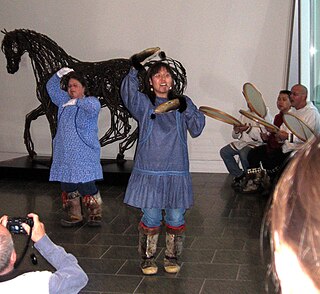Race is a categorization of humans based on shared physical or social qualities into groups generally viewed as distinct within a given society. The term came into common usage during the 16th century, when it was used to refer to groups of various kinds, including those characterized by close kinship relations. By the 17th century, the term began to refer to physical (phenotypical) traits, and then later to national affiliations. Modern science regards race as a social construct, an identity which is assigned based on rules made by society. While partly based on physical similarities within groups, race does not have an inherent physical or biological meaning. The concept of race is foundational to racism, the belief that humans can be divided based on the superiority of one race over another.
An ethnicity or ethnic group is a group of people who identify with each other on the basis of perceived shared attributes that distinguish them from other groups. Those attributes can include a common nation of origin, or common sets of ancestry, traditions, language, history, society, religion, or social treatment. The term ethnicity is often used interchangeably with the term nation, particularly in cases of ethnic nationalism.
The terms multiracial people or mixed-race people refer to people who are of more than one race and the terms multi-ethnic people or ethnically mixed people refer to people who are of more than one ethnicity. A variety of terms have been used both historically and presently for mixed-race people in a variety of contexts, including multiethnic, polyethnic, occasionally bi-ethnic, Métis, Muwallad, Coloured, Dougla, half-caste, ʻafakasi, mestizo, mutt, Melungeon, quadroon, octoroon, sambo/zambo, Eurasian, hapa, hāfu, Garifuna, pardo, and Gurans. A number of these terms are now considered offensive, in addition to those that were initially coined for pejorative use. "Melezi" are called the offspring of Muslim Romani men and woman of host populations.
The term "minority group" has different usages, depending on the context. According to its common usage, the term minority group can simply be understood in terms of demographic sizes within a population: i.e. a group in society with the least number of individuals, or less than half, is a "minority". Usually a minority group is disempowered relative to the majority, and that characteristic lends itself to different applications of the term minority.

In Brazil, Pardo is an ethnic and skin color category used by the Brazilian Institute of Geography and Statistics (IBGE) in the Brazilian censuses. The term "pardo" is a complex one, more commonly used to refer to Brazilians of mixed ethnic ancestries.
The one-drop rule was a legal principle of racial classification that was prominent in the 20th-century United States. It asserted that any person with even one ancestor of black ancestry is considered black. It is an example of hypodescent, the automatic assignment of children of a mixed union between different socioeconomic or ethnic groups to the group with the lower status, regardless of proportion of ancestry in different groups.
Genetic genealogy is the use of genealogical DNA tests, i.e., DNA profiling and DNA testing, in combination with traditional genealogical methods, to infer genetic relationships between individuals. This application of genetics came to be used by family historians in the 21st century, as DNA tests became affordable. The tests have been promoted by amateur groups, such as surname study groups or regional genealogical groups, as well as research projects such as the Genographic Project.
A genealogical DNA test is a DNA-based genetic test used in genetic genealogy that looks at specific locations of a person's genome in order to find or verify ancestral genealogical relationships, or to estimate the ethnic mixture of an individual. Since different testing companies use different ethnic reference groups and different matching algorithms, ethnicity estimates for an individual vary between tests, sometimes dramatically.
Ethnogenesis is the formation and development of an ethnic group. This can originate by group self-identification or by outside identification.

The United States has a racially and ethnically diverse population. At the federal level, race and ethnicity have been categorized separately. The most recent United States census recognized five racial categories, as well as people who belong to two or more of the racial categories. The United States also recognizes the broader notion of ethnicity. The 2000 census and 2010 American Community Survey inquired about the "ancestry" of residents, while the 2020 census allowed people to enter their "origins". The Census Bureau also classified respondents as either Hispanic or Latino, identifying as an ethnicity, which comprises the minority group in the nation.
Social interpretations of race regard the common categorizations of people into different races. Race is often culturally understood to be rigid categories in which people can be classified based on biological markers or physical traits such as skin colour or facial features. This rigid definition of race is no longer accepted by scientific communities. Instead, the concept of 'race' is viewed as a social construct. This means, in simple terms, that it is a human invention and not a biological fact. The concept of 'race' has developed over time in order to accommodate different societies' needs of organising themselves as separate from the 'other'. The 'other' was usually viewed as inferior and, as such, was assigned worse qualities. Our current idea of race was developed primarily during the Enlightenment, in which scientists attempted to define racial boundaries, but their cultural biases ultimately impacted their findings and reproduced the prejudices that still exist in our society today.
Race and health refers to how being identified with a specific race influences health. Race is a complex concept that has changed across chronological eras and depends on both self-identification and social recognition. In the study of race and health, scientists organize people in racial categories depending on different factors such as: phenotype, ancestry, social identity, genetic makeup and lived experience. "Race" and ethnicity often remain undifferentiated in health research.

Native American identity in the United States is a community identity, determined by the tribal nation the individual or group belongs to. While it is common for non-Natives to consider it a racial or ethnic identity, for Native Americans in the United States it is considered to be a political identity, based on citizenship and immediate family relationships. As culture can vary widely between the 574 extant federally recognized tribes in the United States, the idea of a single unified "Native American" racial identity is a European construct that does not have an equivalent in tribal thought.
An ethnoreligious group is a grouping of people who are unified by a common religious and ethnic background.

DNAPrint Genomics was a genetics company with a wide range of products related to genetic profiling. They were the first company to introduce forensic and consumer genomics products, which were developed immediately upon the publication of the first complete draft of the human genome in the early 2000s. They researched, developed, and marketed the first ever consumer genomics product, based on "Ancestry Informative Markers" which they used to correctly identify the BioGeographical Ancestry (BGA) of a human based on a sample of their DNA. They also researched, developed and marketed the first ever forensic genomics product - DNAWITNESS - which was used to create a physical profile of donors of crime scene DNA. The company reached a peak of roughly $3M/year revenues but ceased operations in February 2009.
Multiracial Americans or mixed-race Americans are Americans who have mixed ancestry of two or more races. The term may also include Americans of mixed-race ancestry who self-identify with just one group culturally and socially. In the 2020 United States census, 33.8 million individuals or 10.2% of the population, self-identified as multiracial. There is evidence that an accounting by genetic ancestry would produce a higher number.

The largest ethnic groups in Rwanda are the Hutus, which make up about 85% of Rwanda's population; the Tutsis, which are 14%; and the Twa, which are around 1%. Starting with the Tutsi feudal monarchy rule of the 10th century, the Hutus were a subjugated social group. Belgian colonization also contributed to the tensions between the Hutus and Tutsis. The Belgians and later the Hutus propagated the myth that Hutus were the superior ethnicity. The resulting tensions would eventually foster the slaughtering of Tutsis in the Rwandan genocide. Since then, policy has changed to recognize one main ethnicity: "Rwandan".

There is no single system of races or ethnicities that covers all modern Latin America, and usage of labels may vary substantially.
Biracial and multiracial identity development is described as a process across the life span that is based on internal and external forces such as individual family structure, cultural knowledge, physical appearance, geographic location, peer culture, opportunities for exploration, socio-historical context, etc.

Arab identity is the objective or subjective state of perceiving oneself as an Arab and as relating to being Arab. Like other cultural identities, it relies on a common culture, a traditional lineage, the common land in history, shared experiences including underlying conflicts and confrontations. These commonalities are regional and in historical contexts, tribal. Arab identity is defined independently of religious identity, and pre-dates the spread of Islam and before spread of Judaism and Christianity, with historically attested Arab Muslim tribes and Arab Christian tribes and Arab Jewish tribes. Arabs are a diverse group in terms of religious affiliations and practices. Most Arabs are Muslim, with a minority adhering to other faiths, largely Christianity, but also Druze and Baháʼí.






